Trees Birds Mammals Fish Amphibians Reptiles
Wild Algarve
Bookshop
Entoloma lampropus (Fr.) Hesler - Azureleg Pinkgill
Phylum: Basidiomycota - Class: Agaricomycetes - Order: Agaricales - Family: Entolomataceae
Distribution - Taxonomic History - Etymology - Identification - Culinary Notes - Reference Sources
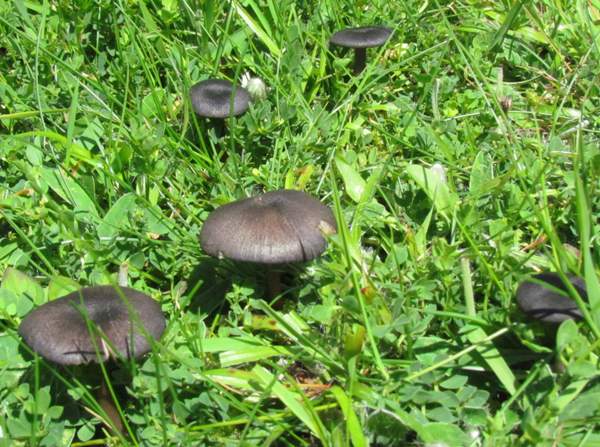
With its steely blue-brown cap and stem, Entoloma lamprobus really deserves a common name, but because it is an infrequent find in Britain and Ireland it does not (yet, as of June 2014) feature in the British Mycological Society's list of English Names of Fungi. The lovely group shown here was found in short-sward grassland at Alyn Waters Country Park, near Wrexham, North Wales during the second week of June 2014.
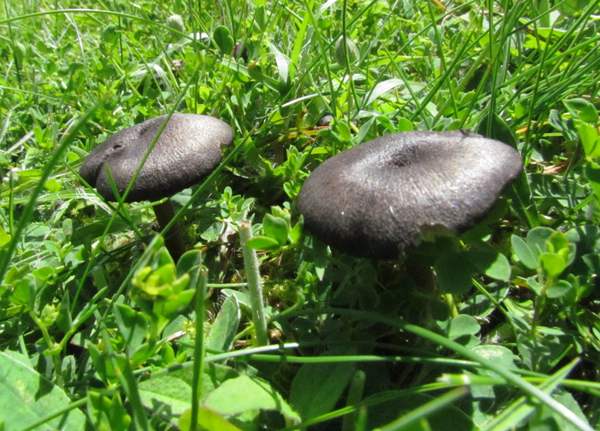
Distribution
This attractive little grassland mushroom is an uncommon find in Britain and Ireland, although it is quite widely distributed. Entoloma lampropus occurs also throughout much of mainland Europe, where it is rarely more than an occasional find, and in parts of North America.
Taxonomic history
When in 1815 Elias Magnus Fries described this species he gave it the scientific (binomial) name Agaricus prunuloides. (Most gilled mushrooms were, in those early days of fungal taxonomy, initially placed in a gigantic Agaricus genus most of whose occupants have since been redistributed across many new genera.) It was American Mycologist Lexemuel Ray Hesler (1888 - 1977) who, in 1967, transferred this species to its present genus, whereupon its scientific name became Entoloma lampropus.
Synonyms of Entoloma lampropus include Agaricus lampropus Fr., Rhodophyllus lampropus (Fr.) Quél., Hyporrhodius lampropus (Fr.) Henn., and Leptonia lampropus (Fr.) Quél.
Etymology
The generic name Entoloma comes from ancient Greek words entos, meaning inner, and lóma, meaning a fringe or a hem. It is a reference to the inrolled margins of many of the mushrooms in this genus.
The specific epithet lamprobus may come from the Cornish probus or lamprobus, the name of a civic parish and village in Cornwall. If not that, then what?
Identification guide
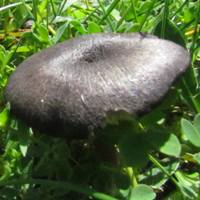 |
Cap
1 to 4cm across; initially conical or hemispherical becoming broadly convex; not hygrophanous; radially fibrillose, often becoming finely scaly; the cap margin is not lined when wet.
|
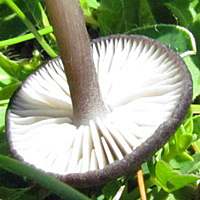 |
Gills
Fairly distant, adnate to emarginate; whitish at first, maturing pale greyish-brown with a pink tinge; gill edges are not lined or intermittently lined blackish (which helps separate this species from Entoloma serrulatum, which has blue-black gill edges.
Stem
Cylindrical sometimes tapering towards the apex; 4 to 8cm long and 2 to 4mm in diameter; longitudinally fibrillose; colour as cap but paler towards the base; no stem ring.
Cheilocystidia (gill-edge cystidia) are absent. |
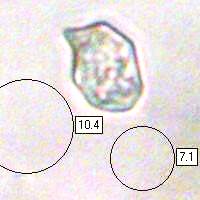 |
Spores
Isodiametrical (broadly ellipsoidal, angular), thin-walled; 8.5-11.5 x 6-8.5μm.
Spore print
Brownish pink. |
Odour/taste |
No significant odour and taste. |
Habitat & Ecological role |
Saprobic in unimproved grassland. |
Season |
Fruiting summer and autumn in Britain and Ireland. |
Similar species |
Entoloma serrulatum has blue-black gill edges.
There are several other bluish Entoloma species, although they are rare finds; key identification features include spore shapes and sizes and the form and dimensions of cystidia on the gill edges. |
Culinary Notes
It is unclear whether this is a toxic toadstool, but as some Entoloma species - for example Entoloma sinuatum - are known to be deadly poisonous it seems sensible to treat Entoloma lampropus as suspect and not to be collected for eating. (Its small size and it scarcity are two more good reasons for not collecting this species other than when necessary for research purposes.)
Reference Sources
Knudsen H., Vesterholt J. (eds) Funga Nordica: agaricoid, boletoid and cyphelloid genera - Nordsvamp, 2008
Dictionary of the Fungi; Paul M. Kirk, Paul F. Cannon, David W. Minter and J. A. Stalpers; CABI, 2008
Taxonomic history and synonym information on these pages is drawn from many sources but in particular from the British Mycological Society's GB Checklist of Fungi.
Top of page...
Fascinated by Fungi. Back by popular demand, Pat O'Reilly's best-selling 450-page hardback book is available now. The latest second edition was republished with a sparkling new cover design in September 2022 by Coch-y-Bonddu Books. Full details and copies are available from the publisher's online bookshop...